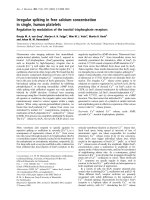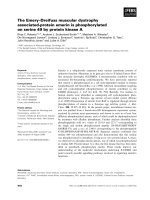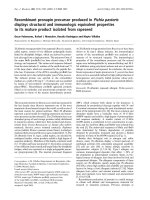Báo cáo y học: " Recombinant phospholipase A1 (Ves v 1) from yellow jacket venom for improved diagnosis of hymenoptera venom hypersensitivit" pptx
Bạn đang xem bản rút gọn của tài liệu. Xem và tải ngay bản đầy đủ của tài liệu tại đây (443.44 KB, 8 trang )
CMA
Seismann et al. Clinical and Molecular Allergy 2010, 8:7
/>Open Access
RESEARCH
BioMed Central
© 2010 Seismann et al; licensee BioMed Central Ltd. This is an Open Access article distributed under the terms of the Creative Commons
Attribution License ( which permits unrestricted use, distribution, and reproduction in
any medium, provided the original work is properly cited.
Research
Recombinant phospholipase A1 (Ves v 1) from
yellow jacket venom for improved diagnosis of
hymenoptera venom hypersensitivity
Henning Seismann
1
, Simon Blank
1
, Liliana Cifuentes
3
, Ingke Braren
2
, Reinhard Bredehorst
1
, Thomas Grunwald
2
,
Markus Ollert*
3
and Edzard Spillner*
1
Abstract
Background: Hymenoptera venoms are known to cause life-threatening IgE-mediated anaphylactic reactions in
allergic individuals. Proper diagnosis of hymenoptera venom allergy using venom extracts is severely affected by
molecular cross-reactivities. Although non-glycosylated marker allergens would facilitate the identification of the
culprit venom, the major allergen phospholipase A1 (Ves v 1) from yellow jacket venom (YJV) remained unavailable so
far.
Methods: Expression of Ves v 1 as wild type and enzymatically inactivated mutant and Ves v 5 in insect cells yielded
soluble proteins that were purified via affinity chromatography. Functionality of the recombinant allergens was
assessed by enzymatic and biophysical analyses as well as basophil activation tests. Diagnostic relevance was
addressed by ELISA-based analyses of sera of YJV-sensitized patients.
Results: Both major allergens Ves v 1 and Ves v 5 could be produced in insect cells in secreted soluble form. The
recombinant proteins exhibited their particular biochemical and functional characteristics and were capable for
activation of human basophils. Assessment of IgE reactivity of sera of YJV-sensitized and double-sensitized patients
emphasised the relevance of Ves v 1 in hymenoptera venom allergy. In contrast to the use of singular molecules the
combined use of both molecules enabled a reliable assignment of sensitisation to YJV for more than 90% of double-
sensitised patients.
Conclusions: The recombinant availability of Ves v 1 from yellow jacket venom will contribute to a more detailed
understanding of the molecular and allergological mechanisms of insect venoms and may provide a valuable tool for
diagnostic and therapeutic approaches in hymenoptera venom allergy.
Background
Hymenoptera stings may cause life-threatening and
sometimes fatal IgE-mediated anaphylactic reactions
with the major threat emanating from the yellow jacket V.
vulgaris and the honeybee A. mellifera. Although venom
immunotherapy is highly effective, an adequate diagnosis
and identification of the culprit venom is hampered by
the use of crude venoms for measurement of specific IgE
levels. Thereby, the main problem arises from serologic
double-positivity for A. mellifera and V. vulgaris venom
of up to 50% of patients that have IgE against
hymenoptera venoms [1]. Apart from true double-sensiti-
sation this phenomenon is largely attributed to molecular
cross-reactivity, either based on the presence of cross-
reactive epitopes in homologues proteins of both venoms
such as the hyaluronidases and dipeptidylpeptidases, or
the presence of so-called cross-reactive carbohydrate
* Correspondence:
,
3
Clinical Research Division of Molecular and Clinical Allergotoxicology,
Department of Dermatology and Allergy, Technische Universität München,
Germany
1
Institute of Biochemistry and Molecular Biology, Department of Chemistry,
University of Hamburg, Germany
Full list of author information is available at the end of the article
Seismann et al. Clinical and Molecular Allergy 2010, 8:7
/>Page 2 of 8
determinants (CCD) which account for 70-80% of cross-
reactive patients found within the double-positive cohort
[2].
Since common diagnostic approaches are not capable
of circumventing or differentiating these cross-reactivi-
ties considerable interest has emerged in strategies
enabling an improved diagnosis. Fail-safe identification of
the culprit venom is imperative for design of appropriate
therapeutic intervention with either one or both venoms
and thus key to any improvement.
The most promising approach for the development of
reliable diagnostics as well as safer and more efficacious
patient-tailored treatment modalities relies on the use of
defined recombinant allergens [3]. For honeybee venom
(HBV), phospholipase A2 (Api m 1) has emerged as sur-
rogate marker, however, for YJV access to native proteins
is limited and only a minor number of recombinant aller-
gens are available [4,5].
The three yellow jacket allergens thought primarily
responsible for IgE-mediated allergic reactions include
phospholipase A
1
(Ves v 1), hyaluronidase (Ves v 2), and
antigen 5 (Ves v 5) [6]. To some extent this estimation is
prompted by the concentration of the particular proteins
in the venom. However, the relevance of Ves v 2 as aller-
gen has been disregarded [7], while the novel high molec-
ular weight compound Ves v 3 recently was reported to
exhibit a pronounced allergenic potential [8]. Both Ves v
2 and Ves v 3 are glycoproteins prone to CCD reactivity
with homologues in HBV.
By contrast, Ves v 1 and Ves v 5 are non-glycosylated
and unique candidates for diagnosis of YJV allergy. While
expression of Ves v 5 could be demonstrated in various
eu- and prokaryotic hosts [9], only insoluble protein was
obtained in scarce attempts of Ves v 1 expression [10]
rendering a reliable assessment of IgE reactivities on the
basis of such a protein questionable.
In this study, we report the successful expression of
both, Ves v 1 and Ves v 5, in insect cells and their subse-
quent biochemical and immunological characterisation.
The unanticipatedly pronounced prevalence of IgE reac-
tivity in YJV-sensitised patients to rVes v 1 emphasises
the need for two unique recombinant major allergens
from YJV, especially in terms of double-positivity.
Methods
Materials
Three groups of sera were selected at random from the
institutional serum bank: (i) Sera with a positive sIgE test
to HBV (i1 ≥0.1 kUa/L) and YJV (i3 ≥ 0.1 kUa/L) (n = 20);
(ii) Sera with a positive sIgE test to YJV only (i3 ≥ 0.1 kUa/
L) (n = 14); (iii) Sera with a positive sIgE test to HBV only
(i1 ≥ 0.1 kUa/L) (n = 5). All patients had given their
informed written consent to draw an additional serum
sample.
Cloning of cDNA
Total RNA was isolated from yellow jacket (Vespula vul-
garis) venom sacks using peqGold TriFast™ (Peqlab Bio-
technologie, Erlangen, Germany). SuperScript III Reverse
Transcriptase (Invitrogen, Karlsruhe, Germany) was used
to synthesize cDNA. Full length Ves v 1 was amplified
with Pfu DNA polymerase (Fermentas, St. Leon-Rot,
Germany) using the primers 5'-GGACCCAAATGTC-
CTTTTAATTC-3' and 5'-AACCGCGGTTAAAT-
TATCTTCCCCTTGTTA-3'. Full length Ves v 5 was
amplified employing the primers 5'-AACAATTATTG-
TAAAATAAAATGTTTGAAA-3' and 5'-CTTTGTTT-
GATAAAGTTCCT-3'. An N-terminal 10-fold His-tag
and a V5 epitope as well as 5' BamHI and 3' NotI restric-
tion sites were added by PCR and the PCR product was
subcloned into the pAcGP67-B baculovirus transfer vec-
tor (BD Pharmingen, Heidelberg, Germany) after restric-
tion digest with BamHI and NotI.
Site directed mutagenesis
For generation of an inactive Ves v 1 form two amino acid
residues in the potential active site were altered by using
the QuikChange Site directed mutagenesis Kit (Stratagen,
La Jolla, USA) according to the manufacturers' recom-
mendations of the employing the primers 5'-CGAT-
TAATTGGACATGGCTTAGGAGCACATG-3' and 5'-
CATGTGCTCCTAAGCCATGTCCAATTAATCG-3' for
S137G exchange and 5'-GAAATTATTGGGCTTGCTC-
CTGCTAGGCCTT-3' and 5'-AAGGCCTAGCAGGAG-
CAAGCCCAATAATTTC-3' for N165A exchange.
Recombinant baculovirus production and expression
Recombinant baculovirus was generated by cotransfec-
tion of Spodoptera frugiperda (Sf9) cells (Invitrogen) with
BaculoGold bright DNA (BD Pharmingen) and the bacu-
lovirus transfer vector pAcGP67-B Ves v 1 or Ves v 5,
respectively, according to recommendations of the manu-
facturer. High titer stocks were produced by three rounds
of virus amplification and optimal multiplicity of infec-
tion (MOI) for recombinant protein expression was
determined empirically by infection of Sf9 cells with
serial dilutions of high titer virus stock.
Expression in baculovirus-infected Sf9 cells
High titer stocks of recombinant baculovirus containing
the Ves v 1 or Ves v 5 coding DNA were used to infect Sf9
cells (1.5-2.0 × 10
6
cells per ml) in a 2000 ml suspension
flask (400 ml suspension culture). For protein production
the cells were incubated at 27°C and 110 rpm for 72 h.
Protein purification
Cellular supernatants were applied to a nickel-chelating
affinity matrix (Ni-NTA-agarose, Qiagen, Hilden, Ger-
many). After washing with NTA-binding buffer (50 mM
sodium phosphate, pH 7.6, 500 mM NaCl) the protein
Seismann et al. Clinical and Molecular Allergy 2010, 8:7
/>Page 3 of 8
was eluted with NTA-binding buffer containing 300 mM
imidazole.
Enzymatic activity of rVes v 1
The enzymatic activity was assessed by use of the
EnzChek Phospholipase A1 Assay Kit (Invitrogen)
according to the recommendation of the manufacturer.
Biophysical analysis of rVes v 5
Dynamic light scattering (DLS) of rVes v 5 was performed
using a Spectroscatterer 201 (RiNA GmbH, Berlin, Ger-
many) equipped with a He-Ne laser providing radiation
with a wavelength of 690 nm and an output power in the
range of 10-50 mW. The sample (30 μl) with a protein
concentration of 0.12 mg/ml in 50 mM sodium phos-
phate, 150 mM NaCl, pH 7.6 were placed in a quartz
cuvette and measured at a constant temperature of 20°C.
Circular dichroism spectra were recorded at 20°C using
a Jasco J-715 spectropolarimeter (Jasco, Groβ-Umstadt,
Germany). A 1-mm optical pathlength quartz cell was
used to obtain spectra in the far-UV region (190 to 260
nm) at a protein concentration of 0.015 mg/ml in 50 mM
sodium phosphate, 150 mM NaCl, pH 7.65 μM. The CD
spectra were acquired at a scan speed of 20 nm/min and a
step resolution of 0.1 nm.
Immunoreactivity of human sera
For assessment of specific IgE immunoreactivity of
human sera in ELISA, 384 well microtiter plates (Greiner,
Frickenhausen, Germany) were coated with recombinant
allergen, nApi m 1 (Latoxan, Valence, France) and the
CCD marker MUXF-BSA (10 μg/ml) (provided by Sie-
mens Healthcare Diagnostics, Los Angeles, USA) at 4°C
overnight and blocked with 40 mg/ml skimmed milk
powder in PBS at room temperature. Human sera were
diluted 1:2 in PBS and applied for 4 hours at room tem-
perature. Wells were rinsed 4 times with PBS and incu-
bated with a monoclonal alkaline phosphatase-
conjugated mouse anti-human IgE antibody (BD
Pharmingen, clone G7-26) diluted 1:1000 in 20 mg/ml
skimmed milk powder in PBS. Wells were again rinsed 4
times with PBS and substrate solution (5 mg/ml 4-nitrop-
henylphosphate, AppliChem, Darmstadt, Germany) was
added. After 30 minutes plates were read at 405 nm.
Basophil activation test
The basophil activation test was essentially performed as
recommended by the manufacturer (Bühlmann Labora-
tories, Basel, Switzerland). Stimulation with recombinant
allergen was performed at protein concentrations of 0.1,
200 and 2000 ng/ml. YJV at a concentration of 50 ng/ml
was used as positive stimulation control served (Bühlm-
ann Laboratories) while plain stimulation buffer was used
as negative stimulation control.
Other methods
SDS-PAGE and Western blotting as well as standard pro-
cedures in molecular biology were performed according
to established protocols [11].
Results
cDNA cloning and recombinant expression in insect cells
For recombinant production of the YJV allergens Ves v 1
and Ves v 5 the particular cDNA was amplified from yel-
low jacket venom gland cDNA. Ves v 1 was produced as a
wild type molecule in order to use the inherent activity as
an indicator of proper folding. However, to avoid poten-
tially detrimental effects of this activity on expression
yields an additional mutant version of phospholipase A1,
Ves v 1 S137G/N165A, lacking phospholipase activity
was generated by site directed mutagenesis.
Subsequently, all proteins were produced by baculovi-
rus-based infection of eukaryotic Sf9 insect cells and
secretion of the proteins into the cellular supernatant.
The epitope tagged rVes v 1 and rVes v 5 were obtained
with yields of approx. 0.2 μg and 1.5 μg, respectively, per
ml of culture supernatant. Thereby, both variants of Ves v
1 could be produced in comparable amounts suggesting
that the phospholipase activity exerts no adverse effect on
expression. In accordance with the native venom proteins
the recombinant analogues exhibited an apparent molec-
ular mass in SDS-PAGE of approx. 37 kDa and 27 kDa
(Fig. 1).
Biochemical characterisation of rVes v 1 and rVes v 5
Prior to an immunological assessment the recombinant
allergens were characterised regarding their molecular
authenticity. Due to the lack of an inherent enzymatic
activity, the physicochemical characteristics of rVes v 5
were analysed by biophysical methods. For E. coli derived
rVes v 5 tendecies towards oligomerisation have been
reported [12]. However, as assessed by DLS measure-
ments (additional file 1) insect cell derived rVes v 5 exhib-
ited clear monodispersity with a hydrodynamic radius of
2.6 +/- 0.4 nm. Furthermore, the structural features of
rVes v 5 as assessed by CD spectroscopy (additional file 2)
were identical to those reported for nVes v 5 [9].
For the rVes v 1 protein, functionality could be
addressed by determining the inherent enzymatic activity
using a colorimetric phospholipase assay (Fig. 2). The
specific activity of the wild type protein was determined
to be approx. 2.5 U/ml at a concentration of 10 μg per ml.
As anticipated, the mutant rVes v 1 S137G/N165A did
not exhibit enzymatic activity. Both, the biophysical data
obtained for rVes v 5 and the enzymatic activity of rVes v
1 clearly suggest proper folding of both insect cell pro-
duced proteins.
Seismann et al. Clinical and Molecular Allergy 2010, 8:7
/>Page 4 of 8
To verify these data in a cell based approach, human
basophils isolated from whole blood of venom allergic
patients were stimulated with rVes v 1 and rVes v 5,
whereby the inactive rVes v 1 S137G/N165A mutant was
employed to avoid unspecific basophil activation through
phospholipase activity. Stimulation with YJV at a concen-
tration of 50 ng/ml served as control. Clear cellular acti-
vation as quantified by CD63 upon stimulation with the
recombinant allergens could be observed over a concen-
tration range from 0.1 ng/ml to 2 μg/ml (Fig. 3; additional
file 3).
Together, these data support the applicability of the
recombinant proteins for cellular approaches in
hymenoptera venom diagnosis and moreover corroborate
the idea that insect cells are an ideal host for expression of
hymenoptera venom proteins.
Immunoreactivity of rVes v 1 and rVes v 5
To reevaluate the immunoreactivity and diagnostic rele-
vance of Ves v 1 and Ves v 5 on a molecular, component
resolved level, individual patient sera of 34 patients with a
positive sIgE test to either HBV and YJV, or YJV only,
were assayed by ELISA for specific IgE antibodies. To fur-
ther provide a broadened reactivity profile and allow for
assignment of sensitisation, nApi m 1, considered a sur-
rogate marker for sensitisation to A. mellifera venom, and
the CCD marker MUXF-BSA that provides the core fuco-
sylated glycotope isolated from pineapple stem bromelain
[13] were included.
Of the 20 double-positive sera (Fig. 4A; additional file
4) 15 showed reactivity to rVes v 1, 10 of which addition-
ally had specific IgE to rVes v 5. Interestingly, only 1 out
of these 20 sera had sIgE to rVes v 5 exclusively, while 2
sera exhibited additional reactivity to Api m 1. In sum-
mary, in this group an overall diagnostic sensitivity of
80% could be achieved by use of two YJV allergens, com-
pared to 50% when using rVes v 5 solely (Fig. 4C). Of the
remaining 4 patients 2 had sIgE for nApi m 1 and 1 was
reactive to the CCD marker MUXF-BSA only. Thus, for
16/20 patients (80%), a particular culprit venom could
convincingly be assigned (Fig. 4C) whereas 2 patients
showed a true double-sensitisation. Only 1 patient
showed reactivity neither to Ves v 1 nor to Ves v 5. Nota-
bly this patient also showed no reactivity to other vespid
proteins such as the hyluronidases Ves v 2a and b and the
dipeptidylpeptidase Ves v 3 (data not shown).
In an additional HBV mono-sensitised control group 4
out of 5 patients had sIgE to Api m 1. As anticipated none
showed reactivity to the yellow jacket allergens and the
CCD marker MUXF-BSA (data not shown).
In the YJV mono-sensitised group (Fig. 4B; additional
file 4) 11 of 14 sera (79%) were reactive to rVes v 1, 7 of
which exhibited additional sIgE reactivity to rVes v 5.
Two further patients showed sIgE reactivity exclusively to
Figure 1 SDS-PAGE and Immunoblot of rVes v 1 and rVes v 5. Left
panel: SDS-PAGE analysis of recombinant allergens recombinantly pro-
duced in Sf9 insect cells visualised by Coomassie Blue staining (lane 1:
rVes v 1; lane 2: rVes v 1 S137G/D165A; lane 3: rVes v 5). Right panel: Im-
munoblot analysis with anti-V5 epitope antibody (lane 1: rVes v 1; lane
2: rVes v 1 S137G/D165A; lane 3: rVes v 5).
rVesv1
rVes v 1
S137G/D165A
rVes v 5
rVesv1
rVes v 1
S137G/D165A
rVes v 5
40 kDa
35 kDa
25 kDa
Figure 2 Enzymatic activity of rVesv 1. Phospholipase activity assay
of rVes v 1 and rVes v 1 S137G/D165A. The recombinant proteins were
used at a concentration of 10 μg/ml. Lecithase
®
ultra at a concentration
of 2.5 U/ml was used as a positive control, while the negative control
was conducted by omission of protein.
0
4000
8000
12000
standard
rVes v 1
rVes v 1
S137G/D165A
control
rel. PLA1 activity (fluorescence)
Seismann et al. Clinical and Molecular Allergy 2010, 8:7
/>Page 5 of 8
rVes v 5. Thus, in summary 13/14 (93%) had detectable
sIgE either to rVes v 1, rVes v 5 or both (Fig. 4C) while 1
patient with low total YJV sIgE showed no reactivity.
Assessment of this serum for specific IgG provided no
evidence for the presence of blocking IgG antibodies
(data not shown). In accordance with the sensitisation of
this group, no reactivities to nApi m 1 were observed.
However, 1 patient exhibited low sIgE reactivity to the
CCD marker.
These data demonstrate that recombinant Ves v 1 is an
essential component to assess the sensitisation of individ-
uals to YJV and its recombinant availability comple-
mented with Ves v 5 and Api m 1 allows for clear
assignment of sensitisation patterns.
Discussion
Standard diagnostic approaches in hymenoptera venom
allergy, but also in plant associated allergies are often
hampered by multiple IgE reactivities affecting the inter-
pretation of ambiguous results and the correct choice of
the proper venom for immunotherapy, a prerequisite for
efficient therapy [1].
Causative for this phenomenon is IgE binding either to
peptide epitopes of closely related or homologous pro-
teins or to conserved carbohydrate structures of related
or otherwise unrelated glycoproteins. Obviously, the
more common incidence in hymenoptera venom allergy
is the latter one, the molecular basis of which could be
attributed to α-1,3-core-fucose and, exclusively in plants
[14], β-1,2-xylose. These residues are absent in mamma-
lian glycosylation and, therefore, constitute a highly
immunogenic epitope in men. In contrast to protein-
directed cross-reactivity, the carbohydrate-directed reac-
tivity in food and hymenoptera allergy is mainly believed
to be clinically irrelevant, but diagnostically cumbersome
[15,16].
Since identification of the culprit venom is strongly
affected by such double positivities the choice of the
proper venom for immunotherapy is often difficult. A
sophisticated method to identify and circumvent such
reactivities are inhibition tests based on mutual inhibi-
tion of IgE by venom of the particular species [17]. How-
ever, these tests are not widely used in standard diagnosis
and the obtained data are difficult to interpret. Hence, the
more advanced and promising option relies on the use of
unique recombinant major allergens which are represen-
tative for the respective venom and fulfil all criteria
regarding high prevalence and low cross-reactivity of
both types.
For HBV, phospholipase A2 (Api m 1) is considered an
ideal surrogate marker as it is structurally unrelated to
the phospholipase A2 in vespid venom and shows a high
prevalence of sIgE recognition [18]. Nevertheless, due to
its nature as glycoprotein cross-reactivity on CCD level is
possible, even if this seems to be reduced in a natural
conformation as indicated by patient sera that showed
Figure 3 Basophil activation. Basophils from two YJV-sensitised patients (A and B) were stimulated with 0.1-2000 ng/ml of rVes v 1 (open squares)
and rVes v 5 (filled circles). Activation was determined by CD63 upregulation in FACS. Control stimulation was performed with 50 ng/ml YJV (dia-
monds).
0
10
20
30
40
50
60
70
80
90
100
basophil activation [% CD63 ]
+
0.1
200
2000
antigen conc. [ng/ml]
YJV
control
0
10
20
30
40
50
60
70
80
90
basophil activation [% CD63 ]
+
0.1
200
2000
antigen conc. [ng/ml]
YJV
control
AB
100
Seismann et al. Clinical and Molecular Allergy 2010, 8:7
/>Page 6 of 8
IgE reactivity to MUXF and glycoproteins of insect origin
(data not shown) but not to Api m 1. No other proteins in
HBV fit to the diagnostic needs due to presence of multi-
ple glycosylation sites and confirmed CCD reactivities.
However, recombinant approaches might offer opportu-
nities for establishment of improved allergen molecules
devoid of glycosylation.
In contrast, YJV contains two non-glycosylated major
allergens without cross-reactive homologues in other
species, Ves v 1 and Ves v 5, both showing high IgE preva-
lence, as shown for proteins purified from venom [19].
Allergens like Ves v 2 a and b and Ves v 3 do not meet
those criteria as they are glycoproteins and in case of the
Ves v 2 isoforms show only minimal IgE prevalence apart
from carbohydrate based IgE binding. In contrast, the
HBV hyaluronidase Api m 2 appears to be a true, but
minor allergen recognised by approx. 30% of sensitised
patients only [7,8]. Furthermore, the dipeptidylpeptidases
from HBV and YJV have been shown to be cross-reactive
due to their high sequence homology [8].
The phospholipase A2 from HBV can be purified from
venom that is easily obtained by electrostimulation, nev-
ertheless, recombinant production could be shown in
bacteria. Although refolded from insoluble aggregates
enzymatic as well as biological activity of the recombi-
nant phospholipase in terms of effector cell activation
proved to be comparable to the native protein [20].
In contrast to Api m 1 and Ves v 5 [9,21] and to the best
of our knowledge, no expression of functional phospholi-
pase A1 from YJV has been reported so far [10]. This is
even more important since the purification from natural
sources is hampered by the significantly higher effort to
obtain substantial amounts of YJV.
However, the approach used in this study, production
of hymenoptera venom allergens in a nearly autologous
system, yielded Ves v 1 for the first time as a soluble and
enzymatically active molecule. Interestingly, expression
of the active enzyme appears not to be detrimental for the
host cells, as shown with the inactive variant of Ves v 1.
This finding might be contributed to the lytic nature of
the baculovirus mediated overexpression, resulting in
apoptosis 48-72 h after infection. Biophysical and bio-
chemical measurements of both recombinant Ves v 1 and
Ves v 5 were entirely in accordance with activity and
native folding. Under the aegis of insect cell-mediated
folding and expression the allergenic characteristics were
compatible even with activation of human basophils, an
ex vivo assay considered to reflect the pathophysiological
situation.
By the use of such defined rVes v 1 and rVes v 5 mole-
cules a true sensitisation to YJV for ≥ 80% of the patients
independently of their sensitisation could be confirmed,
while a true double-sensitisation was verified in only 10%
of the double-positive patients as indicated by additional
sIgE reactivity to nApi m 1. Thereby, the prevalence of
CCD reactive patients was approx. 60% in the double-
positive cohort which is in accordance with the literature
[1] and can be assumed the only reason for cross-reactiv-
ity. In depth follow up studies with increased patient
numbers in the future can provide detailed information
Figure 4 IgE reactivity of patient sera. IgE reactivity of individual pa-
tient sera from double-positive (A) or YJV-positive patients (B) to rVes v
1 and rVes v 5 produced in Sf9 insect cells, nApi m 1, and MUXF-BSA.
The cut-off of the ELISA is indicated by a dashed line (mean back-
ground plus two fold the SD). The percentage of sIgE reactivity to ei-
ther each allergen (Ves v 1 only/Ves v 5 only) or both allergens (Ves v 1
and Ves v 5) is represented in C for double-positive (black bars) or YJV-
positive (grey bars) patients. The overall sIgE reactivity to Ves v 1 or Ves
v 5 (sum Ves v 1 or sum Ves v 5) was obtained by addition of exclusive
sIgE reactivity to one allergen to sIgE reactivity if not recognized exclu-
sively. Overall diagnostic sensitivity (sum) was obtained by addition of
all sIgE reactivities.
rVes v 1 rVes v 5 nApi m 1 MUXF
0.0
0.5
1.0
1.5
2.0
2.5
3.0
absorbance (405 nm)
rVes v 1 rVes v 5 nApi m 1 MUXF
absorbance (405 nm)
0.0
0.5
1.0
1.5
2.0
2.5
3.0
A
B
C
0
10
20
30
40
50
60
70
80
90
100
Vesv1
only
Vesv5
only
Vesv1and
Ves v 5
sum
sIgE reactivity %
sum Ves v 1
sum Ves v 5
Seismann et al. Clinical and Molecular Allergy 2010, 8:7
/>Page 7 of 8
about the prevalence of IgE reactivity as well as clinical
relevance of Ves v 1 and Ves v 5. Additionally, the poten-
tial need for further vespid allergens and implementation
of the allergens into laboratory systems for quantitative
sIgE measurements to enable fail-free detection of all YJV
sensitised individuals should be thoroughly evaluated.
Conclusions
In summary, the use of the defined recombinant major
allergens Ves v 1 and Ves v 5 provides a significant
improvement for the identification of the culprit venom
which is indispensable for the choice of the appropriate
immunotherapeutic strategy. Thereby, the need of Ves v 1
for detection of true sensitisation to YJV could be estab-
lished. Implementation of rVes v 1 to routine diagnosis
thus can allow for assessing its true IgE prevalence and
clinical relevance beyond estimations from immunoblot
studies. Furthermore, component-resolved diagostics
using recombinant allergens such as Ves v 1 and Ves v 5
may provide new insights into the role and relevance of
particular venom compounds during sensitisation and
hyposensitization.
Additional material
Competing interests
The authors declare that they have no competing interests.
Authors' contributions
HS and SB carried out the molecular genetic work, performed the activity tests
and the immunoreactivity analyses and drafted the manuscript. LC performed
the basophil activation tests. IB participated in the design and drafting of the
study and evaluation of the clinical data. RB and TG participated in the design
of the study. MO and ES conceived of the study, and participated in its design
and coordination and helped to draft the manuscript. All authors read and
approved the final manuscript.
Acknowledgements
The contributions of Lars Redecke in terms of biophysical measurements are
gratefully acknowledged.
Author Details
1
Institute of Biochemistry and Molecular Biology, Department of Chemistry,
University of Hamburg, Germany,
2
PLS-Design GmbH, Hamburg, Germany and
3
Clinical Research Division of Molecular and Clinical Allergotoxicology,
Department of Dermatology and Allergy, Technische Universität München,
Germany
References
1. Bilo BM, Rueff F, Mosbech H, Bonifazi F, Oude-Elberink JN: Diagnosis of
Hymenoptera venom allergy. Allergy 2005, 60(11):1339-1349.
2. Hemmer W: Cross-reactivity to honeybee and wasp venom. Hautarzt
2008, 59(3):194-199.
3. Muller UR: Recent developments and future strategies for
immunotherapy of insect venom allergy. Curr Opin Allergy Clin Immunol
2003, 3(4):299-303.
4. Muller UR: Recombinant Hymenoptera venom allergens. Allergy 2002,
57(7):570-576.
5. King TP, Spangfort MD: Structure and biology of stinging insect venom
allergens. Int Arch Allergy Immunol 2000, 123(2):99-106.
6. King TP, Alagon AC, Kuan J, Sobotka AK, Lichtenstein LM:
Immunochemical studies of yellowjacket venom proteins. Mol
Immunol 1983, 20(3):297-308.
7. Seismann H, Blank S, Braren I, Greunke K, Cifuentes L, Grunwald T,
Bredehorst R, Ollert M, Spillner E: Dissecting cross-reactivity in
hymenoptera venom allergy by circumvention of alpha-1,3-core
fucosylation. Mol Immunol 2009, 47(4):799-808.
8. Blank S, Seismann H, Bockisch B, Braren I, Bredehorst R, Ollert MW, Ring J,
Grunwald T, Spillner E: Identification, recombinant expression and
characterization of 100 kDa high molecular weight hymenoptera
venom allergens Api m 5 and ves v 3. J Immunol 2010 in press.
9. Monsalve RI, Lu G, King TP: Expression of yellow jacket and wasp venom
Ag5 allergens in bacteria and in yeast. Arb Paul Ehrlich Inst Bundesamt
Sera Impfstoffe Frankf A M 1999:181-188.
10. King TP, Lu G, Gonzalez M, Qian N, Soldatova L: Yellow jacket venom
allergens, hyaluronidase and phospholipase: sequence similarity and
antigenic cross-reactivity with their hornet and wasp homologs and
possible implications for clinical allergy. J Allergy Clin Immunol 1996,
98(3):
588-600.
11. Ausubel FM: Current Protocols in Molecular Biology. New York: Wiley
Interscience; 1996.
12. Suck R, Weber B, Kahlert H, Hagen S, Cromwell O, Fiebig H: Purification
and immunobiochemical characterization of folding variants of the
recombinant major wasp allergen Ves v 5 (antigen 5). Int Arch Allergy
Immunol 2000, 121(4):284-291.
13. Kuberan B, Gunay NS, Dordick JS, Linhardt RJ: Preparation and isolation
of neoglycoconjugates using biotin-streptavidin complexes. Glycoconj
J 1999, 16(6):271-281.
14. van Ree R, Cabanes-Macheteau M, Akkerdaas J, Milazzo JP, Loutelier-
Bourhis C, Rayon C, Villalba M, Koppelman S, Aalberse R, Rodriguez R, et al.:
Beta(1,2)-xylose and alpha(1,3)-fucose residues have a strong
contribution in IgE binding to plant glycoallergens. J Biol Chem 2000,
275(15):11451-11458.
15. Kochuyt AM, Van Hoeyveld EM, Stevens EA: Prevalence and clinical
relevance of specific immunoglobulin E to pollen caused by sting-
induced specific immunoglobulin E to cross-reacting carbohydrate
determinants in Hymenoptera venoms. Clin Exp Allergy 2005,
35(4):441-447.
16. Mari A: IgE to cross-reactive carbohydrate determinants: analysis of the
distribution and appraisal of the in vivo and in vitro reactivity. Int Arch
Allergy Immunol 2002, 129(4):286-295.
17. Jappe U, Raulf-Heimsoth M, Hoffmann M, Burow G, Hubsch-Muller C, Enk
A: In vitro hymenoptera venom allergy diagnosis: improved by
screening for cross-reactive carbohydrate determinants and reciprocal
inhibition. Allergy 2006, 61(10):1220-1229.
18. Muller UR, Johansen N, Petersen AB, Fromberg-Nielsen J, Haeberli G:
Hymenoptera venom allergy: analysis of double positivity to honey
Additional file 1 DLS measurement of rVes v 5. Dynamic light scattering
measurements were carried out using the Spectroscatterer 201 (RiNA
GmbH). Protein concentration of rVes v 5 was 0.12 mg/ml in 50 mM sodium
phosphate, pH 7.6. rVes v 5 exhibited clear monodispersity with a hydrody-
namic radius of 2.6 +/- 0.41 nm.
Additional file 2 Circular dichroism spectroscopy of rVes v 5. The CD
spectrum for rVes v 5 with a minimum at 208 nm and a shoulder at 225 nm
was superimposable to data reported for native Ves v 5.
Additional file 3 Serological data of patients assessed in basophil
activation. sIgE levels for HBV (i1) and YJV (i3) were determined with the
Immulite 2000 (Siemens Healthcare Diagnostics).
Additional file 4 Serological data of patients assessed in IgE reactivity
analysis. The sIgE levels for HBV (i1) and YJV (i3) were determined with the
Immulite 2000 (Siemens Healthcare Diagnostics) or ImmunoCap 250
(Phadia). In singular cases sIgE values were not determined, but patients
were positive in skin prick testing. For some patients sIgE values are
expressed by classes according to the manufacturer. The sIgE values to rVes
v 1 and rVes v5 were considered as positive (+) at a OD 405 nm > 0.27. Cut
off for high sIgE levels (++) was at OD 405 nm > 1.
Received: 27 January 2010 Accepted: 1 April 2010
Published: 1 April 2010
This article is available from: 2010 Seismann et al; licensee BioMed Central Ltd. This is an Open Access article distributed under the terms of the Creative Commons Attribution License ( .0), which permits unrestricted use, distribution, and reproduction in any medium, provided the original work is properly cited.Clinical and Molecular Allergy 2010, 8:7
Seismann et al. Clinical and Molecular Allergy 2010, 8:7
/>Page 8 of 8
bee and Vespula venom by estimation of IgE antibodies to species-
specific major allergens Api m1 and Ves v5. Allergy 2009, 64(4):543-548.
19. Binder M, Fierlbeck G, King T, Valent P, Buhring HJ: Individual
hymenoptera venom compounds induce upregulation of the basophil
activation marker ectonucleotide pyrophosphatase/
phosphodiesterase 3 (CD203c) in sensitized patients. Int Arch Allergy
Immunol 2002, 129(2):160-168.
20. Forster E, Dudler T, Gmachl M, Aberer W, Urbanek R, Suter M: Natural and
recombinant enzymatically active or inactive bee venom
phospholipase A2 has the same potency to release histamine from
basophils in patients with Hymenoptera allergy. J Allergy Clin Immunol
1995, 95(6):1229-1235.
21. Kischnick S, Weber B, Verdino P, Keller W, Sanders EA, Anspach FB, Fiebig
H, Cromwell O, Suck R: Bacterial fermentation of recombinant major
wasp allergen Antigen 5 using oxygen limiting growth conditions
improves yield and quality of inclusion bodies. Protein Expr Purif 2006,
47(2):621-628.
doi: 10.1186/1476-7961-8-7
Cite this article as: Seismann et al., Recombinant phospholipase A1 (Ves v 1)
from yellow jacket venom for improved diagnosis of hymenoptera venom
hypersensitivity Clinical and Molecular Allergy 2010, 8:7
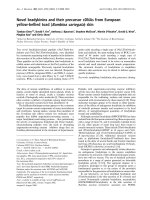
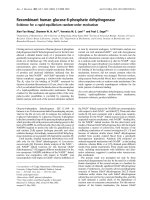
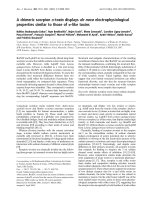
![Báo cáo Y học: The membrane-bound [NiFe]-hydrogenase (Ech) from Methanosarcina barkeri : unusual properties of the iron-sulphur clusters docx](https://media.store123doc.com/images/document/14/rc/ee/medium_eeh1395026426.jpg)
